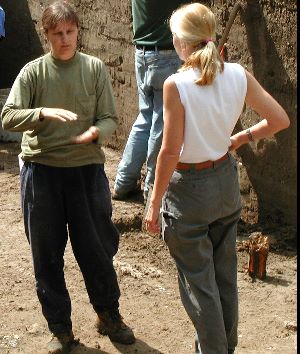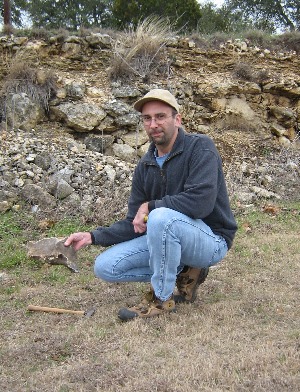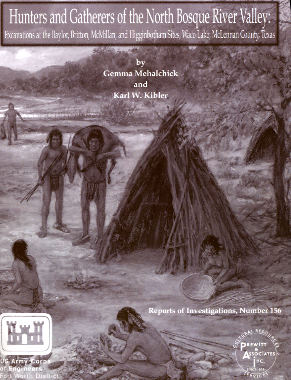This exhibit is based on a report of the Waco Lake investigations by Gemma Mehalchick and Karl Kibler of Prewitt and Associates, Inc., an Austin-based firm that provides archeological and historical consulting services to federal and state agencies, local governments, private industry, and individuals. The U.S. Army Corps of Engineers, Fort Worth District sponsored the archeological investigations at Waco Lake. Corps archeologist Dr. Jay Newman served as the Corps of Engineers technical representative and was instrumental in managing and procuring funds for the project. Along with Corps archeologist Dan McGregor, Dr. Newman oversaw the fieldwork through on-site visits and consultation and reviewed the draft report. Other Corps of Engineers personnel, including former lake manager Kathy Gately and park ranger Bill Key at the Lake Waco office, also played key roles in overseeing the successful completion of the archeological investigations. This exhibit is a public-education component of those investigations.
TBH editor Susan Dial created the exhibit, and David Choi and Kathy Chung of the University of Texas at Austin Liberal Arts Instructional Technology Services developed the exhibit and interactive features. Photographs used in the exhibit, unless otherwise specified, were taken by Prewitt and Associates photographers. Maps and drawings were done by Brian Wootan and Sandy Hannum. The scene of the Native American campsite used in the section, What Was It Like?, was painted by archeologist and artist Frank A. Weir.
Several archeologists at Prewitt and Associates, Inc. were responsible for managing and directing the Waco Lake investigations. Gemma Mehalchick served as Project Archeologist for the data recovery excavations at the Baylor, Britton, McMillan, and Higginbotham sites. Mehalchick, who has participated in archeological projects throughout Texas, Wyoming, Oklahoma, Arkansas, Mississippi, Hawaii, and Egypt, holds a BA in Anthropology from the Pennsylvania State University.
Karl W. Kibler served as Co-Principal Investigator (along with Ross C. Fields) and Project Geomorphologist for the project. His interests in archeology include hunter-gatherer behavior, geoarcheology and paleoenvironments, and Paleoindian and Archaic cultures of Texas and the Southern Plains. He holds an MA degree in Anthropology from the University of Texas at Austin, and has worked for cultural resource management firms and government agencies in Ohio, West Virginia, New York, New Mexico, Wyoming, and Texas, including the last 18 years with Prewitt and Associates, Inc.
Ross Fields served as co-principal investigator for the Waco Lake data recovery project. Fields is President of Prewitt and Associates, Inc. He holds BA and MA degrees in Anthropology from the University of Texas at Austin. Before joining Prewitt and Associates as a Staff Archeologist in 1981, he honed his archeological skills on a variety of projects in east Texas, northeastern Oklahoma, southeastern Alaska, and the Four Corners region of the Southwest. Although he has worked on a variety of projects throughout Texas, his strongest research interests lie in east Texas.
Print Sources
Ameny, Michael A. and Paul W. Wilson
1997 Protein and Amino Acid Contents of Four Whitefleshed African Sweetpotatoes and American Groundnut. African Crop Science Journal 5(2):233–242.
Asch, David L. and Nancy B. Asch
1985 Archeobotany. In Smiling Dan: Structure and Function at a Middle Woodland Settlement in the Illinois Valley, edited by Barbara D. Stafford and Mark B. Sant, pp. 327–401. Research Series Volume 2. Center for American Archeology, Kampsville Archeological Center, Kampsville, Illinois.
Bettinger, Robert L.
1991 Hunter-Gatherers: Archaeological and Evolutionary Theory. Plenum Press, New York.
Binford, Lewis R.
1978 Dimensional Analysis of Behavior and Site Structure: Learning from an Eskimo Hunting Stand. American Antiquity 43(3):330–361.
1979 Organization and Formation Processes: Looking at Curated Technologies. Journal of Anthropological Research 35(3):255–273.
1980 Willow Smoke and Dogs’ Tails: Hunter-Gatherer Settlement Systems and Archaeological Site Formation. American Antiquity 45(1):4–20.
1983 In Pursuit of the Past: Decoding the Archaeological Record. Thames and Hudson, London.
2001 Constructing Frames of Reference: An Analytical Method for Archaeological Theory Building Using Ethnographic and Environmental Data Sets. University of California Press, Berkeley.
Black, Stephen L., Linda W. Ellis, Darrell G. Creel, and Glenn T. Goode
1997 Hot Rock Cooking on the Greater Edwards Plateau: Four Burned Rock Midden Sites in West Central Texas. Studies in Archeology 22. Texas Archeological Research Laboratory, The University of Texas at Austin.
Bobrowsky, Peter T., and Bruce F. Ball
1989 The Theory and Mechanics of Ecological Diversity in Archaeology. In Quantifying Diversity in Archaeology, edited by Robert D. Leonard and George T. Jones, pp. 4–12. Cambridge University Press, Cambridge.
Butzer, Karl W.
1982 Archaeology as Human Ecology: Method and Theory for a Contextual Approach. Cambridge University Press, Cambridge.
Collins, Michael B.
1995 Forty Years of Archeology in Central Texas. Bulletin of the Texas Archeological Society 66:361–400.
Chamberlain, Lucia Sarah
1901 Plants Used by the Indians of Eastern North America. American Naturalist 35 (409):1–10.
Cheatham, Scooter and Marshall C. Johnston
1995 The Useful Wild Plants of Texas, the Southeastern and Southwestern United States, the Southern Plains, and Northern Mexico, Volume 1. Useful Wild Plants, Inc., Austin.
2000 The Useful Wild Plants of Texas, the Southeastern and Southwestern United States, the Southern Plains, and Northern Mexico, Volume 2. Useful Wild Plants, Inc., Austin.
Dyson-Hudson, Rada, and Eric Alden Smith
1978 Human Territoriality: An Ecological Reassessment. American Anthropologist 80:21–41.
Foster, Steven and James A. Duke
1990 A Field Guide to Medicinal Plants and Herbs of Eastern and Central North America. Houghton Mifflin Company, Boston.
Friends of Plants for a Future
1998 Plant Portrait: Apios Americana (American Groundnut). Originally in Friends of Plants for a Future Newsletter. Available at http://www.pfaf.org/leaflets/groundnt.php [accessed January 11, 2007].
Grinnel, George Bird
1923 The Cheyenne Indians: Their History and Ways of Life, Volume 1. Yale University Press, New Haven, Connecticut.
Hall, Grant D.
1998 Prehistoric Human Food Resource Patches on the Texas Coastal Plain. Bulletin of the Texas Archeological Society. 69:1–10.
2000 Pecan Food Potential in Prehistoric North America. Economic Botany 54(1):103–112.
Henry, Donald O., Foster E. Kirby, and Anne B. Justen
1980 The Prehistory of Hog Creek: An Archaeological Investigation of Bosque and Coryell Counties, Texas. Laboratory of Archaeology, Department of Anthropology, University of Tulsa, Oklahoma.
Jochim, Michael A.
1976 Hunter-Gatherer Subsistence and Settlement: A Predictive Model. Academic Press, New York.
1981 Strategies for Survival: Cultural Behavior in an Ecological Context. Academic Press, New York.
Johnson, LeRoy, Jr.
1994 The Life and Times of Toyah-Culture Folk as Seen from the Buckhollow Encampment, Site 41KM16, Kimble County, Texas. Office of the State Archeologist Report No. 38. Texas Department of Transportation and the Texas Historical Commission, Austin.
Kaufman, Daniel
1998 Measuring Archaeological Diversity: An Application of the Jackknife Technique. American Antiquity 63(1):73–85.
Kelly, Robert L.
1983 Hunter-Gatherer Mobility Strategies. Journal of Anthropological Research 39:277–306.
1995 The Foraging Spectrum: Diversity in Hunter-Gatherer Lifeways. Smithsonian Institution Press, Washington, D.C.
Kelly, Robert L., and Lawrence C. Todd
1988 Coming into the Country: Early Paleoindian Hunting and Mobility. American Antiquity 53(2):231–244.
Kent, Susan
1991 The Relationship Between Mobility Strategies and Site Structure. In The Interpretation of Archaeological Spatial Patterning, edited by Ellen M. Kroll and T. Douglas Price, pp. 33–60. Plenum Press, New York.
Konlande, James E. and John R. K. Robson
1972 The Nutritive Value of Cooked Camas as Consumed by Flathead Indians. Ecology and Food Nutrition 2:193–195.
Krebs, J. R.
1978 Optimal Foraging: Decision Rules for Predators. In Behavioural Ecology, edited by J. R. Krebs and N. B. Davies, pp. 23–63. Blackwell Scientific Publications, Oxford.
Kuhn, Steven
1994 A Formal Approach to the Design and Assembly of Mobile Toolkits. American Antiquity 59(3):426–442.
Lintz, Christopher
1995 Dietary Data of Mussel Shell Assemblage. In Early Archaic Use of the Concho River Terraces: Cultural; Resource Investigations at 41TG307 and 41TG309, Tom Green County, San Angelo, Texas. Technical Report 11058, TRC Mariah Associates, Inc., Austin.
Mehalchick, Gemma, and Karl W. Kibler
2008 Hunters and Gatherers of the North Bosque River Valley: Excavations at the Baylor, Britton, McMillan, and Higginbotham Sites, Waco Lake, McLennan County, Texas. Reports of Investigations, No. 156. Prewitt and Associates, Inc., Austin, Texas.
Menhinick, E. F.
1964 A Comparison of Some Species-Individuals Diversity Indices Applied to Samples of Field Insects. Ecology 45:859–861.
Parker, G. A., and John Maynard-Smith
1995 Optimality Theory in Evolutionary Biology. Nature 348:27–33.
Pianka, Eric R.
1978 Evolutionary Ecology, 2nd edition. Harper and Row, New York.
Prewitt, Elton R.
1985 From Circleville to Toyah: Comments on Central Texas Chronology. Bulletin of the Texas Archeological Society 54:201–238.
Quigg, J. Michael
1983 Social Structure at the Ross Glen Tipi Ring Site. In From Microcosm to Macrocosm: Advances in Tipi Ring Investigation and Interpretation, edited by Leslie B. Davis, pp. 305–318. Plains Anthropologist Memoir 19, 28(102), part 2.
Smart, Tristine Lee and Ellen S. Hoffman
1988 Environmental Interpretation of Archaeological Charcoal. In Current Paleoethnobotany: Analytical Methods and Cultural Interpretations of Archaeological Plant Remains, edited by Christine A. Hastorf and Virginia S. Popper, pp. 167–205. The University of Chicago Press, Chicago and London.
Stevenson, Marc G.
1991 Beyond the Formation of Hearth-Associated Artifact Assemblages. In The Interpretation of Archaeological Spatial Patterning, edited by Ellen M. Kroll and T. Douglas Price, pp. 269–300. Plenum Press, New York.
Steward, Julian H.
1955 The Theory of Culture Change. University of Illinois Press, Urbana.
Story, Dee Ann and Harry J. Shafer
1965 1964 Excavations at Waco Reservoir, McLennan County, Texas: The Baylor and Britton Sites. Miscellaneous Papers No. 6. Texas Archeological Salvage Project, The University of Texas at Austin.
Thoms, Alston V.
1989 The Northern Roots of Hunter-Gatherer Intensification: Camas and the Pacific Northwest. Ph.D. dissertation, Department of Anthropology, Washington State University, Pullman.
Thoms, Alston V. (editor)
2004 Yegua Creek Archaeological Project: Survey Results from Lake Somerville State Parks and Trailway, East-Central Texas. Reports of Investigations No. 5, Center for Ecological Archeology, Texas A&M University, College Station.
Wade, Mariah F.
2001 Cultural Fingerprints: The Native Americans of Texas, 1528–1687. Bulletin of the Texas Archeological Society 72:45–54.
2003 The Native Americans of the Texas Edwards Plateau, 1582–1799. University of Texas Press, Austin.
Winterhalder, Bruce
1981a Foraging Strategies in the Boreal Forest: An Analysis of Cree Hunting and Gathering. In Hunter-Gatherer Foraging Strategies: Ethnographic and Archeological Analyses, edited by Bruce Winterhalder and Eric Alden Smith, pp. 66–98. The University of Chicago Press, Chicago.
1981b Optimal Foraging Strategies and Hunter-Gatherer Research in Anthropology: Theory and Models. In Hunter-Gatherer Foraging Strategies: Ethnographic and Archeological Analyses, edited by Bruce Winterhalder and Eric Alden Smith, pp. 13–35. The University of Chicago Press, Chicago.
Yanovsky, Elias, and R. M. Kingsbury
1938 Analyses of Some Indian Plant Foods. Journal of the Association of Official Agricultural Chemists 21(4):648–665.
Yellen, John E.
1977 Archaeological Approaches to the Present: Models for Reconstructing the Past. Academic Press, New York.
Links
U.S. Corps of Engineers Waco Lake website
Information on natural resources and recreational opportunities at the park.
Friends of Plants for a Future
A wealth of data on rare and unusual plants, particularly those which have edible, medicinal or other uses, available from this online center.
See particularly, American Groundnut.
Learning from Cabeza de Vaca: Revelations about Hunter-Gatherer Foodways at the Dawn of Written History in Texas This Texas Beyond History web exhibit by archeologist Alston Thoms draws on the 16th-century accounts of explorer Cabeza de Vaca and his life among the native peoples of south Texas to provide a wealth of information about plant foods and native cooking technologies.
| 


